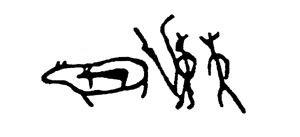Siberia 19th century to 1890 - extreme tourism
1822-other tourists have problems with the secret police
Ledyard was not the only foreign tourist to be suddenly hustled out of the Russian empire by the secret police for inexplicable reasons. There have been many others.
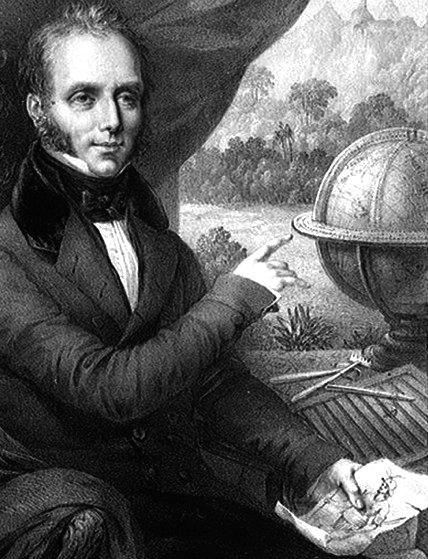 Another British tourist who received this treatment in Siberia, was James Holman who set off across Siberia by himself in 1822. He had been invalided out of the navy when he became ill with joint pains - an affliction which eventually affected his eyes, and lost his eyesight. Always hopeful of a cure for his blindness, he was still determined to fulfill his ambition to travel the world. He wrote about his experiences using a device called a Noctograph, recently invented by Ralph Wedgewood, as a device for writing in the dark for military purposes. It had a wooden frame with wires across as line guides, and metal clips holding down the carbon paper that was used face down over normal paper. Writing on the back of the carbon paper with a special stylus that applied pressure so the carbon was transfered onto the second sheet of ordinary paper, and could be read by the sighted though not by the writer. It can be seen in his portrait for his book "Travels through Russia, Siberia, etc." (London, 1825).
Another British tourist who received this treatment in Siberia, was James Holman who set off across Siberia by himself in 1822. He had been invalided out of the navy when he became ill with joint pains - an affliction which eventually affected his eyes, and lost his eyesight. Always hopeful of a cure for his blindness, he was still determined to fulfill his ambition to travel the world. He wrote about his experiences using a device called a Noctograph, recently invented by Ralph Wedgewood, as a device for writing in the dark for military purposes. It had a wooden frame with wires across as line guides, and metal clips holding down the carbon paper that was used face down over normal paper. Writing on the back of the carbon paper with a special stylus that applied pressure so the carbon was transfered onto the second sheet of ordinary paper, and could be read by the sighted though not by the writer. It can be seen in his portrait for his book "Travels through Russia, Siberia, etc." (London, 1825).
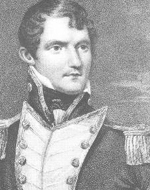
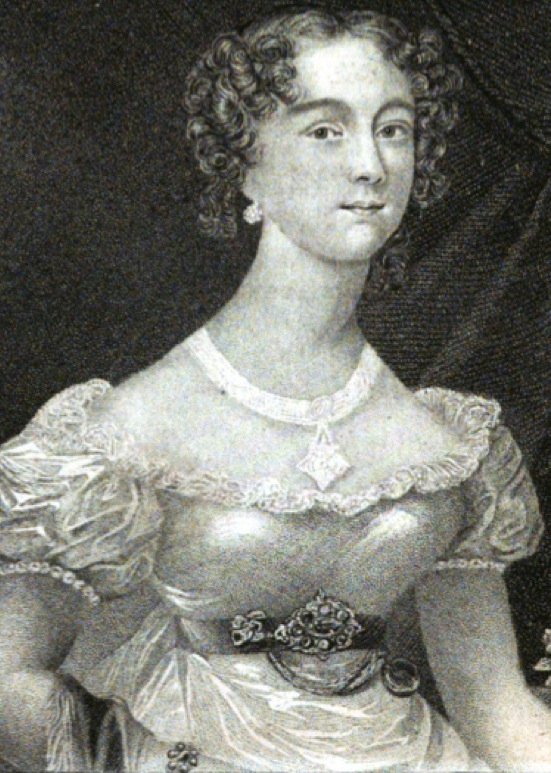 On his way to Siberia Holman met another Royal Navy officer, Scotsman, a brother of Admiral Thomas Cochrane, 10th Earl of Dundonald, Captain John Dundas Cochrane. (Pictures of him and his Kamchatkan wife on right). Who also had planned to walk round the world. He had got as far as Kamchatka when he fell in love with the 14-year-old daughter of a native chief (Cochrane was 44)and was heading back home with his bride ( when Holman met him. On his return home Cochrane wrote up his recent travels in a book: published in 1823, A Pedestrian Journey Through Russia and Siberian Tartary to the Frontiers "of China, the Frozen Sea and Kamchatka". Cochrane died in Venezuela in 1825 while travelling through South America.
On his way to Siberia Holman met another Royal Navy officer, Scotsman, a brother of Admiral Thomas Cochrane, 10th Earl of Dundonald, Captain John Dundas Cochrane. (Pictures of him and his Kamchatkan wife on right). Who also had planned to walk round the world. He had got as far as Kamchatka when he fell in love with the 14-year-old daughter of a native chief (Cochrane was 44)and was heading back home with his bride ( when Holman met him. On his return home Cochrane wrote up his recent travels in a book: published in 1823, A Pedestrian Journey Through Russia and Siberian Tartary to the Frontiers "of China, the Frozen Sea and Kamchatka". Cochrane died in Venezuela in 1825 while travelling through South America.
Holman had hired a cart and driver and got as far as Irkutsk, where he had to wait until he could get a passage across Lake Baikhal and continue with his journey.
In the early 19th century, Irkutsk was flourishing as trading and administrative centre on the Angara river, and hence the ancient river route leading from the Arctic and the Yenessei river, via the Angara to Lake Baikhal, a trading route. It had recently further benefitted by the opening up of the Siberian Trakt, a direct road from Moscow, rough though it was, it meant there was provision for means of transport and somewhere (usually grim) to stay the nights on the way. Irkutsk was established as a trading post on major trade routes and frontier town - being near the frontier with China. It was now filling with the classier exiles and traders, industrialists, and travellers, and was established as the capital city and centre of government for Eastern Siberia. A devastating fire in 1879, means that the buildings you see now nearly all date after this.
Particulary notable is the governor's residence, the museum, and the embankment along the river lined with apple trees which in June when I was there were all in blossom.
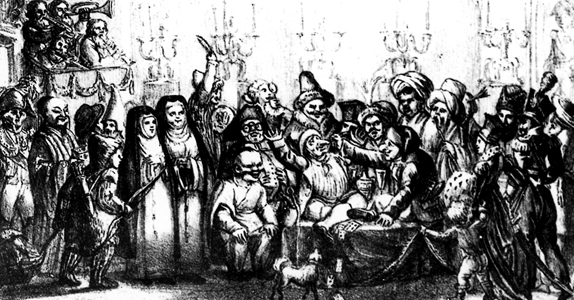
Holman was given hospitality by the Governor General Lavinski, and by a rich young English widow, Mrs. Bentham, originally from London, who lived there with her 10-year old son. Parties with fancy dress and native Buryats and Tungus in their colourful ethnic festival clothes, and visits to people and places of interest, were arranged for him, and he spent Christmas with Mrs. Bentham. Meanwhile, while he was enjoying he friendship of the Governor - the Governor had sent a message back to the Tsar.
Meanwhile an agent of the Tsar was on his way. Just after New Year's Day Alexey Kolotovin arrived to immediately escort the blind Englishman as fast as possible, back to Moscow to get money from his bank since he was epected to pay the expenses for his arrest - and out of Russia - arrangements were made at the border with Poland to convey him further.
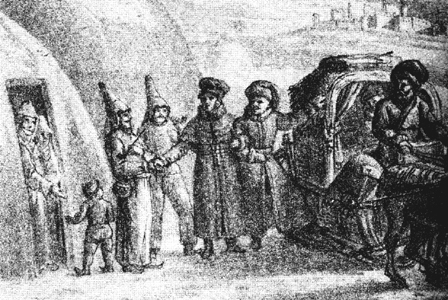
Holman did get the opportunity to visit some Kirghiz near Omsk on the way, and also met another stranded Englishman. In Moscow he managed to smuggle out notes to tell people of his plight, but he was being spied on continously.
The peculiar mixture of warm hospitality and appalling hostility to mixing with foreigners at home and abroad, is an old characteristic of Russian bureaucracy.
As Giles Fletcher says in his book "Of The Russe Commonwealth" in 1591:
"You shall seldome see a Russe a traveller except he be with some ambassadour, or that he make a scape out of his countrie. Which hardly he can doo, by reason of the borders that are watched so narrowly, and the punishment for any such attempt which is death if he be taken, and all his goods confiscate...
Neither doo they suffer any stranger willingly to come into their realme out of any civile countrie for the same cause, farther then necessitie of uttering their commodities and taking in of forreine doth enforce them to doo.
And therefore this year 1589 they consulted about the removing of all marchants straungers to the border townes, to abide and have their residencie there, and to bee more wary in admitting other straungers hereafter into the inland parts of the realm, for feare of infection with better manners and qualities then they have of their owne."
1814-1847 missionaries and outlaws
In 1814 The London Missionary Society in Stepney planned to send missionaries to the heathen peoples of Eastern Siberia.
They also thought it would be useful to have a British outpost on the trade routes and lines of communication between Russia and China. They aimed for the Buryats and the Yakuts. They did not get far in Yakutia, (at least those that did go there were never heard of again), but did get established for many years with the Buryats. In hopeless competition with the Buddhist missionaries, and the traditional shamans. Their main success was their little school.
The English missionaries were not allowed to make converts as the Russian Orthodox church maintained a government authorised monopoly on conversions.
The Bishop of Irkutsk headed an Orthodox mission to Yakutia and claimed to have converted practically the whole Yakut population. They were fined five kopeks if they did not attend church.
In fact most of the population never saw a church in their lives. Shlovsky, who was exiled to Yakutia in the early 1890s, said that "In this region it often happens that Yakuts are born, get married and die without ever seeing a priest, and when by chance a priest comes, he baptises the children, marries the parents and says the funeral service for perhaps twenty dead."
Kate Marsden discovered that the lepers were fortunate if they were visited by a priest once a year.
Thus, despite persecution of shamans, and attempts at suppression, the traditional Yakut religion has survived to the present. The only lasting result of the attempt at mass Christianisation, was that everyone had Russian names or Russianized Yakut names, or Yakutized Russian names.
In 1822 Governor-General M.M.Speransky reformed the Yasak the taxation of the natives. The native communities were catagorized as settled - living permanently in villages; nomadic - migrating between summer and winter homes - Yakuts came into this category; and wandering - this included Evenks, Evens and Yukaghirs. All the land was to be the property of the Russian state, so natives had to follow its rules.
The Yakuts, who were, everyone of them, classified as "nomadic" were placed under the control of a "Steppe Council" composed of the clan chiefs - the Toyons.
This gave the Toyons unregulated authority within their clan territories, which meant they could use this power in allocating land and in trading with the Tungus, against Russian regulations. The Steppe Duma was abolished in 1838, but the clan directorates and native offices remained.
Yakut was the only Siberian native language which gained a foothold in Russian town society. In other Siberian towns, the local natives had no place except as servants, craftsmen and small traders, but in Yakutsk, many of the Russians and exiles learnt the Yakut language and used it even at the Governor's dinner parties.
The Yakuts unlike most of the Siberian people, actually increased in numbers and imposed their customs and language on their conquerors.
Yakut became the lingua franca all over Eastern Siberia - and Alaska in the 19th century. It was essential for communication with the different nationalities of the region - the Tungus, Yukaghir etc. All needed to speak Yakut, Russian was less important. The Yakuts rivalled the Russians as traders, not only in Eastern Siberia but in Alaska "Russian America".
Traditional ways of helping the poor and needy, were undermined and there was no aid from the Russian government to which everyone paid taxes, no hospitals and doctors, no schools, no poor relief. Terrible famine, even cannibalism was usual each spring when the stored food ran out.
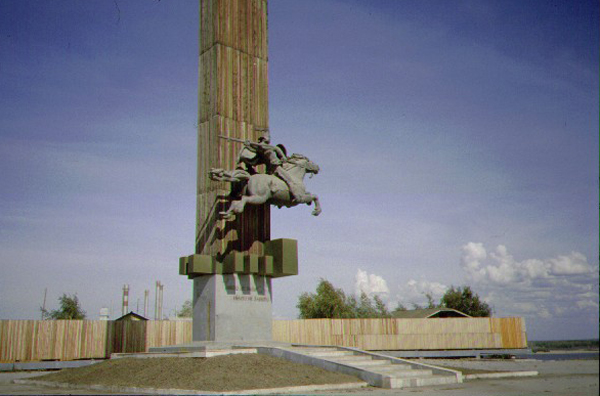 Gangs of Yakut outlaws lived in the forests, ambushing travellers and rustling cattle. The most famous of these outlaws was Vasily Manchary - the Yakut Robin Hood. He was arrested several times and always managed to escape from prison. So in 1847, he was sentenced to be shackled to the prison wall for ten years. There is now a very tall monument to him in Yakutsk.
Gangs of Yakut outlaws lived in the forests, ambushing travellers and rustling cattle. The most famous of these outlaws was Vasily Manchary - the Yakut Robin Hood. He was arrested several times and always managed to escape from prison. So in 1847, he was sentenced to be shackled to the prison wall for ten years. There is now a very tall monument to him in Yakutsk.
Famous exiles - Decembrist
It was December 1825. Tsar Alexander I had died, and although Grand Duke Constantine was to be Tsar, he stepped aside in favour of his younger brother Nicholas. But the Imperial troops aleady made the oath of allegance to Constantine and now had to to make a new oath to Nicholas. Some of the officers decided to take advantage of the confusion. They had been in the Napoleanic Wars, had travelled, and been inspired by the changes in France and the rest of Europe. The Northern group headed by Guard-Captain Nikita Muraviev favoured a constitution patterned on that of the new USA. The Southern group under Colonel Paul Prestel wanted Revolutionary and Napoleonic France as a model for a new government. Both united in wanting a new constitution bring educational opportunities and social justice to the peoples of the Russian Empire. The organisation included several princes and princesses, courtiers and freemasons - it was led from the top of the social ladder.
On December 14, the troops were to take the oath to Tsar Nicholas. The officers at St. Petersburg told the men who were stationed in the central square in the presence of the Tsar to shout "Long Live Constantine and the Constitution!" But Nicholas I had already been informed. The military Governor of St. Petersburg was killed and the Tsar ordered his own troops to fire on the others.
The conspirators became known as the Decembrists. They were imprisoned in the PeterPaul fortress and sentenced. Some thirty were hanged - the rest sent to Sibera. Because of their prominent social positions and popular cause, there was much sympathy and support for them, on their journey through Siberia to Irkutsk and beyond.
When a convict or dissendent was exiled, they became legally dead, their spouse was free to remarry. In fact many wives and families accompanied their loved ones to Siberia, having nothing left for them back home. - This was allowed by law anyway.
 Princess Trubetstoi insisted on accompanying her husband. Because of the publicity caused by her celebrity status, obstacles were put in her way, but she insisted on her rights even if it meant losing all her possessions and status. Princess Volkonsky followed her a year later when she recovered from the birth of her baby.
Princess Trubetstoi insisted on accompanying her husband. Because of the publicity caused by her celebrity status, obstacles were put in her way, but she insisted on her rights even if it meant losing all her possessions and status. Princess Volkonsky followed her a year later when she recovered from the birth of her baby.
The Decembrists started to arrive in Irkutsk from 1826 and were then sent on to other places to serve their sentences.
After two years the Decembrists were settled at Chita in Buryatia
in South Siberia, and then Petrovsk for two years. After which they were no longer prisoners and settled in Siberia on grants of land. With the resources of their social position at their disposal they helped to develop this area and introduced better amenities in the towns.
They were to have a great affect on the cultural development of Irkutsk and the area generally.
HMS Plover in Chukotka and "Russian America" 1845
The HMS Plover arrived at Chukotka in 1848, to overwinter, on its way to search for Franklin's expedition. Sir John Franklin was the commander of the two Arctic Discovery Ships, the "Erebus" and the "Terror" which had set out from England in 1845. Nothing had been heard of them since and by 1847, Franklin's anxious wife ensured that the navy sent ships to look for them.
Three different expeditions were launched to search different parts of the Arctic Ocean. HMS Plover under Commander T.E.L.Moore who had experience in polar seas set off from Plymouth on 30th January 1848 to search through the Bering Straits - still little explored. They sailed via Madeira, the Falklands, Cape Horn and arrive at Honolulu, in what was then called the Sandwich Islands, on the 23rd August 1848. Lt. William Hulme Hooper who was to write a book on the expedition "Ten Months among the Tents of the Tuski", said of Honolulu "I thought it a perfect paradise."
They soon had to leave, laden with tropical fruit for their journey north to the Bering Strait heading for Kotzebue Sound where they were supposed to overwinter. By the night of the 15th October the ship was in difficulties with the winds, currents, and icy evidence of winter settling in.
Early in the morning they came in sight of the coast, with huts and people running around and launching boats towards them. They were welcomed on board and the Plover was led into a safe harbour and three days later the ship was iced in. Since they were in a safe harbour, the Captain decided that they would over-winter there.
As the title of the book shows, they were there for ten months. And thoroughly enjoyed the hospitality of their Chukchi hosts.
The men had heads shaved with just an outer rim left and they were furry parkas and trousers with boots. Women were tougher still. They wore furry jumpsuits which had to be pulled down to go to toilet (anywhere convenient), and when working or indoors were pulled off leaving the top bare and showing off their tattoes.
The Chukchi tents (yaranga) had an inner room where the family and their guests crowded together to live and sleep and use a bucket. Each morning the housewife emptied the bucket which froze into ice in the outer tent and had to light a fire. It took her about twenty minutes to get a fire going with a fireboard so when the crew of the Plover arrived with matches the ladies would do anything to get them. (No complaints).
When the others got up then each housewife had to take down the leather linings of the inner room and take them outside where the condensation froze to ice and could be beaten out, so the cleaner, dryer tent could be put back again.
The Captain and crew of the Plover enjoyed their welcome from the Chuckchi ladies and also the clothes they made for them. They did not appreciate the Chukchi ladies' cooking so much as it included blubber, cakes made from the contents of the reindeer's stomach, little frozen raw fishes (Hooper and his companions tried to scrape the insides out with their finger-nails), and for the sweet, whale gums. Not what they were used to at home.
More on Chukchi history and traditions with pictures in Chukchi Directions.
It was not until the 13th June that the ice around the Plover began to melt. They now headed for their intended destination of Kotzebue Sound and joined up with HMS Herald to search the Northern coast of Alaska.
Hooper was to leave the ship the following winter and travel back via Canada. Franklin's expedition was not found this time - by then, although they did not know it, Franklin and the crews of both ships had all perished.
The captain of the Plover, was court-martialled on his return to England, accused of enjoying sleighrides with his Chukchi mistress, instead of searching for Franklin. There is more in Chukchi directions of time and space.
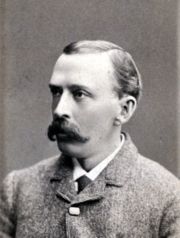
George Kennan, Telegrah Poles, and Koryaks
George Kennan wrote a book about his experiences called "Tent Life in Siberia" which was published in 1870. From 1865 to 1867, Kennan was employed by the Western Union Telegrah Company to build an overland line from America to Europe, by way of Alaska, the Bering Straits, and across Siberia into Russia and thence to the rest of Europe.
The work of these engineers in placing lines of telegraph poles across some of he remotest and ruged parts of the world was forgotten after the sucessful installation of the trans-Atlantic cable. The enterprise was under the auspices of the Russian-American Telegraph Company.
Kennan described his life with the Koryaks in the far east of Siberia. They were reindeer herders like the Chukchi, and lived to the south of them. Language and customs were related but the Koryaks lived a slighty different way. The men were described as solid, brutal looking, dressed in spotted deerskin clothes, wearing strings of coloured beads in their ears, and carrying heavy knives two feet in length tied around their legs. The elderly and infirm who could no longer work, as with the Chukchi, were killed. At ceremonies dogs were sacrificed and fastened to posts with wreaths around their necks. (Similar practice carried out in east England in the iron age). And they got intoxicated by chewing the red mushrooms with white spots on (fly agaric) which was recycled by drinking their pee.
Kennan describes the Koryak homes:
Crawling on hands and knees a distance of 12 or 15 feet through the low doorway, we entered the large open circle in the interior of the tent. A crackling fire of resinous pine broughs burned brightly upon the fround in the centre, illuminating redly the framwork of black glossy poles, and flickering fitfully over the dingy skins of the roof and the swarthy tattoed faces of the women who squatted around. A large copper kettle, filled with some mixture of questionable odor and appearance, hung over the blaze, and furnished occupation to a couple of skinny bare-armed women, who with the same sticks were attentively stirring its contents, poking up the fire, and knocking over the head 2 or 3 lazy dogs. The smoke which rose lazily from the fire, hang in a blue, clearly defined cloud about 5 feet from the ground, dividing the atmosphere of the tent into a lower stratum of comparatively clean air, and an upper cloud region where smoke, vapours and ill odors contested for supremacy."......
The interior of a Koyak yurt presents a strange and not very inviting appearance to one who has never been accustomedby long habit to its dirt, smoke, and frigid atmosphere. It receives its only light and that of a cheerless gloomy character, through the round hole, about 20 ft. above the floor, which serves as window, door, and chimney, and which is reached by a round log with holes in it. The beams, rafters and logs which compose the yurt are all of glossy blackness from the smoke in which they are constantly enveloped. A wooden platform, raised about a foot from the earth, extends out from the walls on three sides to a width of 6 ft. leaving an open spot 8 or 10 ft. in diameter in the centre for the fire and a huge coppy kettle of melting snow. On the platform are pitched 3 or 4 square skin pologs (inner tents) which serve as sleeping quarters for the inmates and as refuges from the smoke which sometimes becomes almost unendurable. A little circule of flat stones on the fround in the centre of the yurt forms the firelace over which is usually simmering a kettle of fish or reindeer meat, which with dried salmon, seal's blubber, and rancid oil makes up the Korryak bill of fare. Everything you see or touch bears the distinguishing marks of Koryak origins - grease and smoke.
....
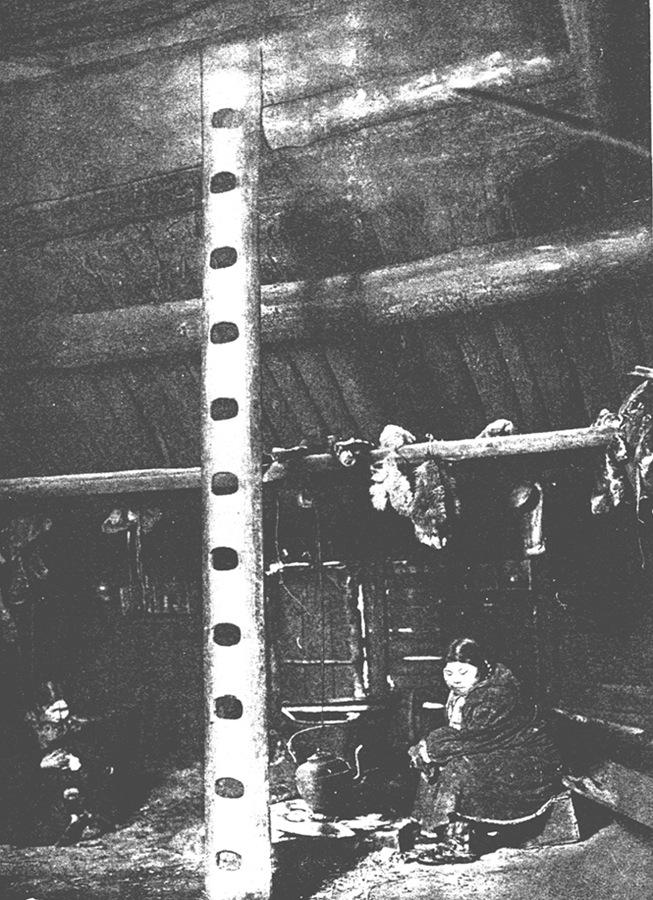 When snow drifts up against the yurt so as to give the the dogs access to the chimney, they take a perfect delight in lying around the hole, peering down into the yurt and sniffing the odours of boiling fish which rise from the huge kettle underneath. Not infrequently they get into a grand comprehensive free fight for the best place of observation; and just as you are about to take your dinner of boiled salmon off the fire, down comes a struggling yelping dog into the kettle, while his triumphant antagonist looks down through the chimney hole with all the complacency of gratified vengeance upon his unfortunate victim. A Koryak takes the half-scalded dog by the back of the neck, carries him up the chimney, pitches him over the edge of the yurt into a snowdrift, and returns with unruffled serenity to eat the fish soup which has thus been irregularly flavoured with dog and thicked with hairs. Hairs, and especially reindeer's hairs are among the indispensable ingredients of everything cooked in a Koryak yurt.
When snow drifts up against the yurt so as to give the the dogs access to the chimney, they take a perfect delight in lying around the hole, peering down into the yurt and sniffing the odours of boiling fish which rise from the huge kettle underneath. Not infrequently they get into a grand comprehensive free fight for the best place of observation; and just as you are about to take your dinner of boiled salmon off the fire, down comes a struggling yelping dog into the kettle, while his triumphant antagonist looks down through the chimney hole with all the complacency of gratified vengeance upon his unfortunate victim. A Koryak takes the half-scalded dog by the back of the neck, carries him up the chimney, pitches him over the edge of the yurt into a snowdrift, and returns with unruffled serenity to eat the fish soup which has thus been irregularly flavoured with dog and thicked with hairs. Hairs, and especially reindeer's hairs are among the indispensable ingredients of everything cooked in a Koryak yurt.
......
Dwellings right across the north including Europe were similar to this - up to about two thousand years ago - and until the 18th and even 19th century in the far north. In winter the only access was through the chimney which is why a tradition remained that spirits could enter the house through the chimney - iron blades where inserted into fireplaces to stop them - and of course father xmas still enters our homes that way - - See also Mammoth Hunters.
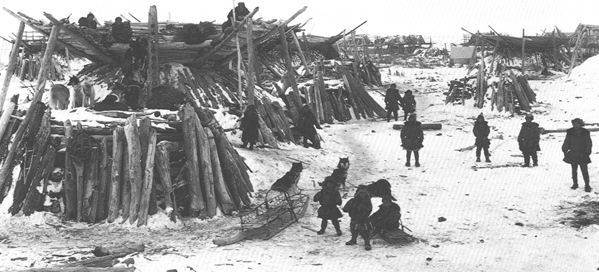 When Waldemar and Dina Jochelson arrived at a Koryak village to study the Koryak as part of the Jesup North Pacific Expedition - 1897 to 1902, they found it deserted - nearly half of the inhabitants had died in a measles epidemic and the others left. They had to travel on to Penshina Bay by the North Pacific Ocean, where they had to remain during the winter. Although they had lived in Yakutia as exiles and now they were back as experienced American ethnographers, they hated it there:
When Waldemar and Dina Jochelson arrived at a Koryak village to study the Koryak as part of the Jesup North Pacific Expedition - 1897 to 1902, they found it deserted - nearly half of the inhabitants had died in a measles epidemic and the others left. They had to travel on to Penshina Bay by the North Pacific Ocean, where they had to remain during the winter. Although they had lived in Yakutia as exiles and now they were back as experienced American ethnographers, they hated it there:
"It is almost imossible to describe the squalor of these dwellings. The smoke, which fills the hut, makes the eyes smart....Walls, ladder and household utensils are covered with a greasy soot....The odor of blubber and of refuse is almost intolerable; and the inmates, intoxicated with fly agaric, add to the discomfort of the situation. The natives are infested with lice...."
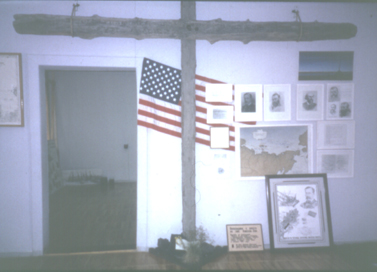
In 1879, George Washington De Long, a lieutenant in the U.S. Navy, planned to reach the North Pole by ship. De Long had Arctic experience. His expedition was sponsored by James Gordon Bennett of the New York Herald, who also sponsored Stanley's search for Livingstone.
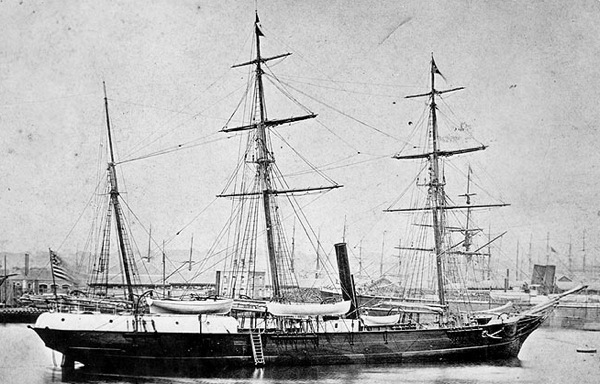 The ship called the Jeannette, was originally named the Pandora in which Sir Allen Young had attempted the North West passage in 1875 and had been bought for the expedition by Bennett. She sailed from San Francisco, collected dogs in Alaska (for the sleds) and headed through the Bering Strait hoping to drift with the Japanese Current and find a large land mass above Wrangel Island.
The ship called the Jeannette, was originally named the Pandora in which Sir Allen Young had attempted the North West passage in 1875 and had been bought for the expedition by Bennett. She sailed from San Francisco, collected dogs in Alaska (for the sleds) and headed through the Bering Strait hoping to drift with the Japanese Current and find a large land mass above Wrangel Island.
But she became stuck in the ice and had to drift with it. Wrangel Island turned out to be smaller than expected. Two very little islands were discovered and called Jeanette and Henriette.
In summer 1881, the Jeannette was still stuck, and breaking up under the pressure of the ice. The men abandoned ship just in time and watched her sink. During a six-week trek across the ice they found two more little islands, which they called De Long and Bennett. When they reached Bennett island they rested here a few days, then made for the Siberian mainland by three boats. They only had enough food for a few weeks and ice still lay thickly in the sea although it was already August. They made very slow progress.
Then a gale blew up and scattered the three boats. One was never to be seen again. The second commanded by Lieutenant Melville was lucky enough to reach an inhabited part of the Lena delta and the crew were given shelter in a village.
The third boat commanded by De Long also reached land but in an uninhabited part of the islands of the Lena delta. They finished their food and were too weak to travel further. Two of the fittest were sent ahead to get help, but by the time they reached the village where Melville was, it was too late in the winter to return and find and rescue the others.
The next spring Melville searched for them by sled. Only bodies were found. De Long had watched the others die one by one until he himself died on 1st November 1881.
Three years later some things from the Jeanette were washed up on the South West coast of Greenland. This was to give a clue to the Arctic currents for future Arctic explorers.
The discovery of the remains of the Jeanette inspired arctic explorer and professor of zoology, Fridtjof Nansen to trace the drift of the ice in his ship the Fram in 1893-96. The Fram, which had been purpose built for the Arctic, was allowed to drift through the ice - a journey which took three years. After a year, in March 1895, Nansen left the ship with a companion, Hjalmar Johansen, 3 sledges, 2 kayaks, and 28 dogs, to walk to the North Pole. A month later they realised they were making little progress and had no chance of achieving this goal, so they headed back south towards some islands on their maps which in fact did not exist. Eventually in July, they found some islands and made a shelter to spend the winter. Nansen and Johansen managed to survive and in May, headed off south. A month later they were rescued by a British expedition on Franz Joseph Land.
The memorial and relics of De Long and his crew can be seen in the museum at Tiksi.
Tiksi is very much a Soviet city on the shores of the Arctic Ocean, surrounded by Tundra, with an small airport (in 1993 with some rotting cold war planes) and a huge array of antenna on nearby hills.
Tiksi was also the starting point in February 1994, for an expedition across the North Pole in aid of the Save the Children fund, which planned to follow on foot, the currents in which the Jeanette drifted across the North Pole. This drift of ice which travels a few kilometres a day was followed by the Save the Children team members David Mitchell, Stephen Martin, and Clive Johnson, and their progress reported in the Education Guardian each Tuesday until after three weeks they asked to be rescued by plane.
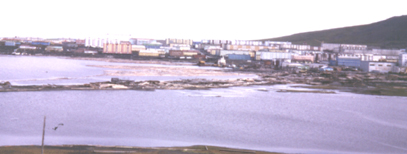 Tiksi is now a popular base for Arctic explorations and tourists. I was amongst the first batch of British tourists in 1993. As we approached we could see the antenna - part of the cold war, but also handy for televison, and other communications, and the logs and sunken ships in the harbour.
Tiksi is now a popular base for Arctic explorations and tourists. I was amongst the first batch of British tourists in 1993. As we approached we could see the antenna - part of the cold war, but also handy for televison, and other communications, and the logs and sunken ships in the harbour.
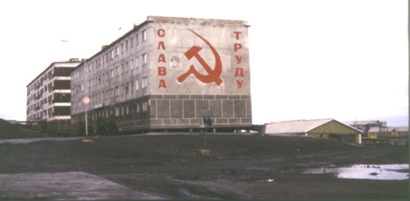 Tiksi was a Stalinist city and has Soviet blocks of flats - on pillars but still collapsing into the bumpy roads due to the permafrost - which also means they have rows of winter toilets - outside loos in little huts for winter when the pipes freeze. - The bright slogans are now historic art.
Tiksi was a Stalinist city and has Soviet blocks of flats - on pillars but still collapsing into the bumpy roads due to the permafrost - which also means they have rows of winter toilets - outside loos in little huts for winter when the pipes freeze. - The bright slogans are now historic art.
 In the central square the small bust of Lenin is dwarfed by a massive horses hitching post topped by a choron.
In the central square the small bust of Lenin is dwarfed by a massive horses hitching post topped by a choron.
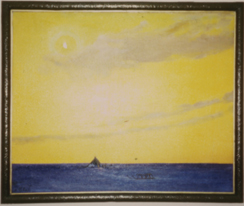 We were shown the art gallery with its bright sunny paintings to cheer up the dark cold winter so near the north pole, and the art college, the school of music etc. Giant though tatty greenhouses are everywhere - the only way to grow fruit and veg in the arctic tundra.
We were shown the art gallery with its bright sunny paintings to cheer up the dark cold winter so near the north pole, and the art college, the school of music etc. Giant though tatty greenhouses are everywhere - the only way to grow fruit and veg in the arctic tundra.
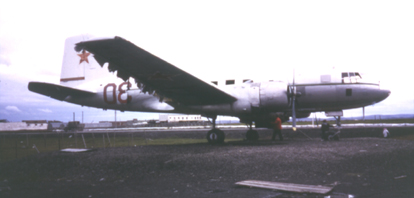 We were taken in the city's bus fleet - two odd and decrepit machines,
to see the airport (the first time foreigners could see it).
We were taken in the city's bus fleet - two odd and decrepit machines,
to see the airport (the first time foreigners could see it).
 with our guide - an Evenk student (then) called Sardana after the Sakha Republic's national flower the Sardana.
with our guide - an Evenk student (then) called Sardana after the Sakha Republic's national flower the Sardana.
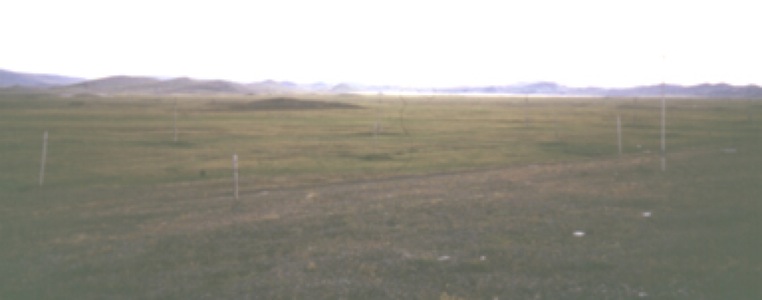 and on to a scientific institute on the tundra - but it was shut and we met a scientist collecting mushrooms. They do research into the environment, pollution of the atmosphere, the ozone hole etc. The tundra was covered in flowers, those which would come out in spring or autumn further south, like forgetmenots and michaelmas daises, are flowering together in the short summer on the arctic tundra, and some of the tiny shrubs are trees further south.
and on to a scientific institute on the tundra - but it was shut and we met a scientist collecting mushrooms. They do research into the environment, pollution of the atmosphere, the ozone hole etc. The tundra was covered in flowers, those which would come out in spring or autumn further south, like forgetmenots and michaelmas daises, are flowering together in the short summer on the arctic tundra, and some of the tiny shrubs are trees further south.
V. L. Prikolovsky
Two years after the loss of the Jeanette, V. L. Prikolovsky succeeded in getting to Yakutia to survey the country. As he put it-
"The return through Yakutsk of the American survivors of the steamer Jeanette, icebound in the Lena delta; the horrible death of two thirds of the crew of that steamer; then the burning of the American steamer Regers in Komochinskaya Bay at Serdtse-kamen; the difficult sojourn of our scientific hermits at the Sagastyr Meteorological Station at the mouth of the Lena; the transporting of the corpses of the deceased Americans; the arrival in Yakutsk of correspondents of the New York Herald - all these circumstances made a special impression not only on our government but on neighbouring states, and attracted the attention of the whole reading public; which followed with interest all that took place in that cheerless, distant region. With this growing interest in the Yakutsk Territory, my own desire also grew to get acquainted at first hand with the tundra, of which so much had been said that was impossible and improbable, especially by foreigners. I managed to realise my dream, thanks to the benevolent attention of the Governor General of Eastern Siberia, Dmitri Gavrilovich Anuchin"......
It took him two months to reach Yakutsk from Poland. When he arrived at Yakutsk he was disappointed to find it lacking the museum and library
(soon to be built and still there although crumbling into the permafrost) he was expecting to find to help his researches.
He had to get out into the field.
It took him 132 days to get to Verkhoyansk where he wished to study the conditions of life of the natives.
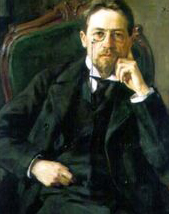
1890: Anton Chekhov goes to look at the prison camps of Sakhalin
Anton Chekov, is famous now for his plays like the Seagull, but in 1890, that was to come. It was as a physician as well as a writer, that he set out in 1890 for Sakhalin to look at conditions at the prison camps there. By this time, he was in poor health, with the chronic tuberculosis that was eventually to kill him. It was the death of his brother from tuberculosis in 1889 that motivated him to go to Sakhalin. He arrived in Irkutsk in June 1890 and found it the best of the Siberian towns at the time. (He was scathing about Tomsk.)
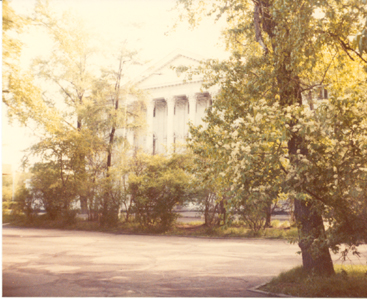 The governors house as seen here with apple trees in front, was rebuilt after Irkutsk had been almost totally gutted by fire in 1879. The city including its public buildings, had been mostly built from wood, which make fires, some caused by malicious arson, even more devastating. The suburbs and surrounding villages are still mainly of wood.
The governors house as seen here with apple trees in front, was rebuilt after Irkutsk had been almost totally gutted by fire in 1879. The city including its public buildings, had been mostly built from wood, which make fires, some caused by malicious arson, even more devastating. The suburbs and surrounding villages are still mainly of wood.
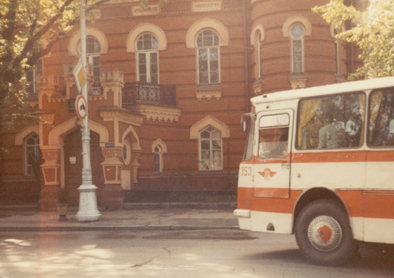 The museum and library at Irkutsk largly contributed to by exiles. The Intourist bus outside marks bygone cold war era when tourists were rushed through the interesting ethnic exhibits to be shown only Russian exhibits. The museum has the wonderful artefacts from the people who lived in this region during the height of the last ice age, as well as interesting relics from the local people, the Buryats and Evenk.
The museum and library at Irkutsk largly contributed to by exiles. The Intourist bus outside marks bygone cold war era when tourists were rushed through the interesting ethnic exhibits to be shown only Russian exhibits. The museum has the wonderful artefacts from the people who lived in this region during the height of the last ice age, as well as interesting relics from the local people, the Buryats and Evenk.
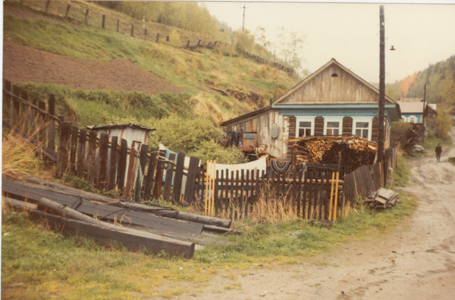 One of the houses by Lake Baikhal. Although much of the old town of Irkutsk was destroyed by fire, and rebuilt, the villages by the shores of Baikhal did not look much different in 1983 to what they would have looked a century earlier - and houses still have outside loos, especially for winter use.
One of the houses by Lake Baikhal. Although much of the old town of Irkutsk was destroyed by fire, and rebuilt, the villages by the shores of Baikhal did not look much different in 1983 to what they would have looked a century earlier - and houses still have outside loos, especially for winter use.
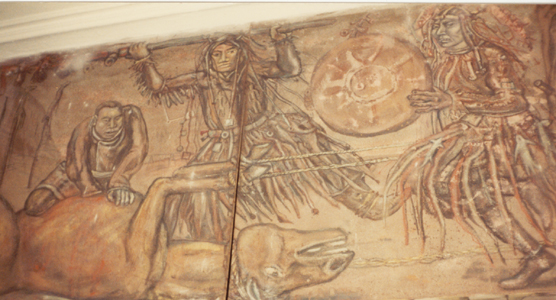
A fresco in the museum shows the Buriat shamans in a ritual, sacrificing a horse.
To travel east from Irkutsk in 1890 which was before the railway had reached so far, it was necessary to cross Baikhal by ferry (unless it was frozen) to join the river Selenga, then Shilka and Amur. Travel by boat was much easier than traveling overland, where it was possible. And this is still the case today - though the 20th century also brought welcome air transport to Siberia.
From Irkutsk Chekov travelled by the steam ships along the Shilka, then the Amur which he found very pleasant, there were people who had become rich from gold prospecting, and there were Japanese prostitutes. Chekov who was still unmarried at this time, described his session with one in a letter.
He describes the people he met on the way, some of whom he treated as patients. Some were political exiles: "Out here nobody worries about saying what he things. There is no one to arrest you and nowhere to exile people to..." . "...There is no culture of denouncing people here."
It took Chekov nearly three months to get to Sakhalin from Moscow, and he spent 2 months there. He found that he had no help from the people he had contacted before his trip with regard to his work there.
The island of Sakhalin is the northern most island of the Japanese island chain and had been occupied by Gilyaks and Ainu before the Russian government seized it and dumped their convicts there.
Chekov made a survey of the whole of Sakhalin. He counted the people and surveyed each settlement. He described the condition of the surviving Gilyaks as well as that of the prisoners and prison camps. The prisoners had come from all walks of life and levels of society. Some had managed and struggled to make the best of their circumstances and lived in villages with their families, but others were dependent on inadequate and bad government supplies and treatment was cruel with floggings and hangings as routine. More on the history of Sakhalin.
Chekov returned home by sea via Singapore.
The next part of the story
Other links:
 Another British tourist who received this treatment in Siberia, was James Holman who set off across Siberia by himself in 1822. He had been invalided out of the navy when he became ill with joint pains - an affliction which eventually affected his eyes, and lost his eyesight. Always hopeful of a cure for his blindness, he was still determined to fulfill his ambition to travel the world. He wrote about his experiences using a device called a Noctograph, recently invented by Ralph Wedgewood, as a device for writing in the dark for military purposes. It had a wooden frame with wires across as line guides, and metal clips holding down the carbon paper that was used face down over normal paper. Writing on the back of the carbon paper with a special stylus that applied pressure so the carbon was transfered onto the second sheet of ordinary paper, and could be read by the sighted though not by the writer. It can be seen in his portrait for his book "Travels through Russia, Siberia, etc." (London, 1825).
Another British tourist who received this treatment in Siberia, was James Holman who set off across Siberia by himself in 1822. He had been invalided out of the navy when he became ill with joint pains - an affliction which eventually affected his eyes, and lost his eyesight. Always hopeful of a cure for his blindness, he was still determined to fulfill his ambition to travel the world. He wrote about his experiences using a device called a Noctograph, recently invented by Ralph Wedgewood, as a device for writing in the dark for military purposes. It had a wooden frame with wires across as line guides, and metal clips holding down the carbon paper that was used face down over normal paper. Writing on the back of the carbon paper with a special stylus that applied pressure so the carbon was transfered onto the second sheet of ordinary paper, and could be read by the sighted though not by the writer. It can be seen in his portrait for his book "Travels through Russia, Siberia, etc." (London, 1825).

 On his way to Siberia Holman met another Royal Navy officer, Scotsman, a brother of Admiral Thomas Cochrane, 10th Earl of Dundonald, Captain John Dundas Cochrane. (Pictures of him and his Kamchatkan wife on right). Who also had planned to walk round the world. He had got as far as Kamchatka when he fell in love with the 14-year-old daughter of a native chief (Cochrane was 44)and was heading back home with his bride ( when Holman met him. On his return home Cochrane wrote up his recent travels in a book: published in 1823, A Pedestrian Journey Through Russia and Siberian Tartary to the Frontiers "of China, the Frozen Sea and Kamchatka". Cochrane died in Venezuela in 1825 while travelling through South America.
On his way to Siberia Holman met another Royal Navy officer, Scotsman, a brother of Admiral Thomas Cochrane, 10th Earl of Dundonald, Captain John Dundas Cochrane. (Pictures of him and his Kamchatkan wife on right). Who also had planned to walk round the world. He had got as far as Kamchatka when he fell in love with the 14-year-old daughter of a native chief (Cochrane was 44)and was heading back home with his bride ( when Holman met him. On his return home Cochrane wrote up his recent travels in a book: published in 1823, A Pedestrian Journey Through Russia and Siberian Tartary to the Frontiers "of China, the Frozen Sea and Kamchatka". Cochrane died in Venezuela in 1825 while travelling through South America.

 Gangs of Yakut outlaws lived in the forests, ambushing travellers and rustling cattle. The most famous of these outlaws was Vasily Manchary - the Yakut Robin Hood. He was arrested several times and always managed to escape from prison. So in 1847, he was sentenced to be shackled to the prison wall for ten years. There is now a very tall monument to him in Yakutsk.
Gangs of Yakut outlaws lived in the forests, ambushing travellers and rustling cattle. The most famous of these outlaws was Vasily Manchary - the Yakut Robin Hood. He was arrested several times and always managed to escape from prison. So in 1847, he was sentenced to be shackled to the prison wall for ten years. There is now a very tall monument to him in Yakutsk. Princess Trubetstoi insisted on accompanying her husband. Because of the publicity caused by her celebrity status, obstacles were put in her way, but she insisted on her rights even if it meant losing all her possessions and status. Princess Volkonsky followed her a year later when she recovered from the birth of her baby.
Princess Trubetstoi insisted on accompanying her husband. Because of the publicity caused by her celebrity status, obstacles were put in her way, but she insisted on her rights even if it meant losing all her possessions and status. Princess Volkonsky followed her a year later when she recovered from the birth of her baby.
 When snow drifts up against the yurt so as to give the the dogs access to the chimney, they take a perfect delight in lying around the hole, peering down into the yurt and sniffing the odours of boiling fish which rise from the huge kettle underneath. Not infrequently they get into a grand comprehensive free fight for the best place of observation; and just as you are about to take your dinner of boiled salmon off the fire, down comes a struggling yelping dog into the kettle, while his triumphant antagonist looks down through the chimney hole with all the complacency of gratified vengeance upon his unfortunate victim. A Koryak takes the half-scalded dog by the back of the neck, carries him up the chimney, pitches him over the edge of the yurt into a snowdrift, and returns with unruffled serenity to eat the fish soup which has thus been irregularly flavoured with dog and thicked with hairs. Hairs, and especially reindeer's hairs are among the indispensable ingredients of everything cooked in a Koryak yurt.
When snow drifts up against the yurt so as to give the the dogs access to the chimney, they take a perfect delight in lying around the hole, peering down into the yurt and sniffing the odours of boiling fish which rise from the huge kettle underneath. Not infrequently they get into a grand comprehensive free fight for the best place of observation; and just as you are about to take your dinner of boiled salmon off the fire, down comes a struggling yelping dog into the kettle, while his triumphant antagonist looks down through the chimney hole with all the complacency of gratified vengeance upon his unfortunate victim. A Koryak takes the half-scalded dog by the back of the neck, carries him up the chimney, pitches him over the edge of the yurt into a snowdrift, and returns with unruffled serenity to eat the fish soup which has thus been irregularly flavoured with dog and thicked with hairs. Hairs, and especially reindeer's hairs are among the indispensable ingredients of everything cooked in a Koryak yurt. When Waldemar and Dina Jochelson arrived at a Koryak village to study the Koryak as part of the Jesup North Pacific Expedition - 1897 to 1902, they found it deserted - nearly half of the inhabitants had died in a measles epidemic and the others left. They had to travel on to Penshina Bay by the North Pacific Ocean, where they had to remain during the winter. Although they had lived in Yakutia as exiles and now they were back as experienced American ethnographers, they hated it there:
When Waldemar and Dina Jochelson arrived at a Koryak village to study the Koryak as part of the Jesup North Pacific Expedition - 1897 to 1902, they found it deserted - nearly half of the inhabitants had died in a measles epidemic and the others left. They had to travel on to Penshina Bay by the North Pacific Ocean, where they had to remain during the winter. Although they had lived in Yakutia as exiles and now they were back as experienced American ethnographers, they hated it there: 
 The ship called the Jeannette, was originally named the Pandora in which Sir Allen Young had attempted the North West passage in 1875 and had been bought for the expedition by Bennett. She sailed from San Francisco, collected dogs in Alaska (for the sleds) and headed through the Bering Strait hoping to drift with the Japanese Current and find a large land mass above Wrangel Island.
The ship called the Jeannette, was originally named the Pandora in which Sir Allen Young had attempted the North West passage in 1875 and had been bought for the expedition by Bennett. She sailed from San Francisco, collected dogs in Alaska (for the sleds) and headed through the Bering Strait hoping to drift with the Japanese Current and find a large land mass above Wrangel Island. Tiksi is now a popular base for Arctic explorations and tourists. I was amongst the first batch of British tourists in 1993. As we approached we could see the antenna - part of the cold war, but also handy for televison, and other communications, and the logs and sunken ships in the harbour.
Tiksi is now a popular base for Arctic explorations and tourists. I was amongst the first batch of British tourists in 1993. As we approached we could see the antenna - part of the cold war, but also handy for televison, and other communications, and the logs and sunken ships in the harbour. Tiksi was a Stalinist city and has Soviet blocks of flats - on pillars but still collapsing into the bumpy roads due to the permafrost - which also means they have rows of winter toilets - outside loos in little huts for winter when the pipes freeze. - The bright slogans are now historic art.
Tiksi was a Stalinist city and has Soviet blocks of flats - on pillars but still collapsing into the bumpy roads due to the permafrost - which also means they have rows of winter toilets - outside loos in little huts for winter when the pipes freeze. - The bright slogans are now historic art. In the central square the small bust of Lenin is dwarfed by a massive horses hitching post topped by a choron.
In the central square the small bust of Lenin is dwarfed by a massive horses hitching post topped by a choron. We were shown the art gallery with its bright sunny paintings to cheer up the dark cold winter so near the north pole, and the art college, the school of music etc. Giant though tatty greenhouses are everywhere - the only way to grow fruit and veg in the arctic tundra.
We were shown the art gallery with its bright sunny paintings to cheer up the dark cold winter so near the north pole, and the art college, the school of music etc. Giant though tatty greenhouses are everywhere - the only way to grow fruit and veg in the arctic tundra. We were taken in the city's bus fleet - two odd and decrepit machines,
to see the airport (the first time foreigners could see it).
We were taken in the city's bus fleet - two odd and decrepit machines,
to see the airport (the first time foreigners could see it).
 with our guide - an Evenk student (then) called Sardana after the Sakha Republic's national flower the Sardana.
with our guide - an Evenk student (then) called Sardana after the Sakha Republic's national flower the Sardana. and on to a scientific institute on the tundra - but it was shut and we met a scientist collecting mushrooms. They do research into the environment, pollution of the atmosphere, the ozone hole etc. The tundra was covered in flowers, those which would come out in spring or autumn further south, like forgetmenots and michaelmas daises, are flowering together in the short summer on the arctic tundra, and some of the tiny shrubs are trees further south.
and on to a scientific institute on the tundra - but it was shut and we met a scientist collecting mushrooms. They do research into the environment, pollution of the atmosphere, the ozone hole etc. The tundra was covered in flowers, those which would come out in spring or autumn further south, like forgetmenots and michaelmas daises, are flowering together in the short summer on the arctic tundra, and some of the tiny shrubs are trees further south.
 The governors house as seen here with apple trees in front, was rebuilt after Irkutsk had been almost totally gutted by fire in 1879. The city including its public buildings, had been mostly built from wood, which make fires, some caused by malicious arson, even more devastating. The suburbs and surrounding villages are still mainly of wood.
The governors house as seen here with apple trees in front, was rebuilt after Irkutsk had been almost totally gutted by fire in 1879. The city including its public buildings, had been mostly built from wood, which make fires, some caused by malicious arson, even more devastating. The suburbs and surrounding villages are still mainly of wood. The museum and library at Irkutsk largly contributed to by exiles. The Intourist bus outside marks bygone cold war era when tourists were rushed through the interesting ethnic exhibits to be shown only Russian exhibits. The museum has the wonderful artefacts from the people who lived in this region during the height of the last ice age, as well as interesting relics from the local people, the Buryats and Evenk.
The museum and library at Irkutsk largly contributed to by exiles. The Intourist bus outside marks bygone cold war era when tourists were rushed through the interesting ethnic exhibits to be shown only Russian exhibits. The museum has the wonderful artefacts from the people who lived in this region during the height of the last ice age, as well as interesting relics from the local people, the Buryats and Evenk. One of the houses by Lake Baikhal. Although much of the old town of Irkutsk was destroyed by fire, and rebuilt, the villages by the shores of Baikhal did not look much different in 1983 to what they would have looked a century earlier - and houses still have outside loos, especially for winter use.
One of the houses by Lake Baikhal. Although much of the old town of Irkutsk was destroyed by fire, and rebuilt, the villages by the shores of Baikhal did not look much different in 1983 to what they would have looked a century earlier - and houses still have outside loos, especially for winter use.
